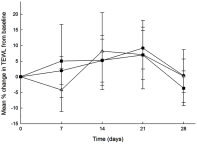Use of formulations for sensitive skin improves the visible signs of aging, including wrinkle size and elasticity
- PMID: 31239745
- PMCID: PMC6559254
- DOI: 10.2147/CCID.S212240
Use of formulations for sensitive skin improves the visible signs of aging, including wrinkle size and elasticity
Abstract
Background: Sensitive skin affects an increasingly large proportion of the population and is less tolerant to frequent and prolonged use of cosmetics. This study investigates the antiaging effects of a skin care system developed for use on sensitive skin. Methods: A total of 30 healthy Caucasian females, aged 32-72, were enrolled in this double-blind randomized placebo-controlled split-face study. A routine consisting of twice daily topical applications of the test cleanser and test moisturizer or placebo or positive control products was followed for 28 days, with parameters measured at baseline and at 7-day intervals. Objective skin assessments for hydration, transepidermal water loss (TEWL), skin surface topography, elasticity and safety assessment were conducted. Results: Wrinkle surface, length and depth significantly improved by 34.8±4.7% (P<0.001), 19.0±3.2% (P<0.05) and 24.3±3.5% (P<0.05), respectively, after 28 days of skin care treatment with the test cleanser and test moisturizer. R2 (gross elasticity), R5 (net elasticity) and R7 (biological elasticity) significantly increased by 32.8±6.5% (P<0.001), 47.3±8.6% (P<0.001) and 50.6±5.1% (P<0.001), respectively, while R6 (viscoelastic portion) significantly decreased by 33.4±4.6% (P<0.001) after 28 days. Skin hydration was also found to increase significantly after 28 days by 42.2±8.5% (P<0.01), but there was no change in TEWL. No adverse events were reported. Conclusions: A novel skin care routine developed for use on sensitive skin significantly improves the signs of aging including hydration, wrinkle size and elasticity without significant adverse effects.
Keywords: avenanthramides; elasticity; hydration; nicotinamide; vitamin E; wrinkles.
Conflict of interest statement
Fabrizio Spada, Ada H Lui and Tanya M Barnes are employed by Ego Pharmaceuticals, the sponsor of the study and manufacturer of the QV Face product range. Fabrizio Spada and Ada H Lui report that they have the patent AU2014386711 pending. The authors report no other conflicts of interest in this work.
Figures





 ) positive control, n=15 subjects and (
) positive control, n=15 subjects and ( ) test cleanser/moisturizer, n=15 subjects. Results are presented as mean ± SEM. *P<0.001 versus placebo, †P<0.01 versus placebo, #P<0.05 versus placebo.
) test cleanser/moisturizer, n=15 subjects. Results are presented as mean ± SEM. *P<0.001 versus placebo, †P<0.01 versus placebo, #P<0.05 versus placebo.

Similar articles
-
An antiaging skin care system containing alpha hydroxy acids and vitamins improves the biomechanical parameters of facial skin.Clin Cosmet Investig Dermatol. 2014 Dec 19;8:9-17. doi: 10.2147/CCID.S75439. eCollection 2015. Clin Cosmet Investig Dermatol. 2014. PMID: 25552908 Free PMC article.
-
Oral Supplementation of Low-Molecular-Weight Collagen Peptides Reduces Skin Wrinkles and Improves Biophysical Properties of Skin: A Randomized, Double-Blinded, Placebo-Controlled Study.J Med Food. 2022 Dec;25(12):1146-1154. doi: 10.1089/jmf.2022.K.0097. J Med Food. 2022. PMID: 36516059 Clinical Trial.
-
Oral Intake of Hydrangea serrata (Thunb.) Ser. Leaves Extract Improves Wrinkles, Hydration, Elasticity, Texture, and Roughness in Human Skin: A Randomized, Double-Blind, Placebo-Controlled Study.Nutrients. 2020 May 28;12(6):1588. doi: 10.3390/nu12061588. Nutrients. 2020. PMID: 32481760 Free PMC article. Clinical Trial.
-
Recent advances in characterizing biological mechanisms underlying UV-induced wrinkles: a pivotal role of fibrobrast-derived elastase.Arch Dermatol Res. 2008 Apr;300 Suppl 1:S7-20. doi: 10.1007/s00403-007-0798-x. Arch Dermatol Res. 2008. PMID: 17968573 Review.
-
Use of Collagen in Cosmetic Products.Curr Issues Mol Biol. 2024 Mar 4;46(3):2043-2070. doi: 10.3390/cimb46030132. Curr Issues Mol Biol. 2024. PMID: 38534748 Free PMC article. Review.
Cited by
-
Long-term effects of two 24-hour moisturizing products on skin barrier structure and function: A biometric and molecular study.Health Sci Rep. 2021 Jun 6;4(2):e308. doi: 10.1002/hsr2.308. eCollection 2021 Jun. Health Sci Rep. 2021. PMID: 34141902 Free PMC article.
-
Skin Recovery After Discontinuation of Long-Term Moisturizer Application: A Split-Face Comparison Pilot Study.Dermatol Ther (Heidelb). 2020 Dec;10(6):1371-1382. doi: 10.1007/s13555-020-00453-0. Epub 2020 Oct 7. Dermatol Ther (Heidelb). 2020. PMID: 33026578 Free PMC article.
-
A nanohybrid synthesized by polymeric assembling Au(I)-peptide precursor for anti-wrinkle function.Front Bioeng Biotechnol. 2022 Dec 12;10:1087363. doi: 10.3389/fbioe.2022.1087363. eCollection 2022. Front Bioeng Biotechnol. 2022. PMID: 36578506 Free PMC article.
-
Analysis of the Bacterial Flora of Sensitive Facial Skin Among Women in Guangzhou.Clin Cosmet Investig Dermatol. 2021 Jun 15;14:655-664. doi: 10.2147/CCID.S307668. eCollection 2021. Clin Cosmet Investig Dermatol. 2021. PMID: 34163204 Free PMC article.
References
-
- Brenneisen P, Sies H, Scharfetter-Kochanek K. Ultraviolet B irradiation and matrix metalloproteinases: from induction via signaling to initial events. Ann N Y Acad Sci. 2002;973:31–43. - PubMed
-
- Rokhsar CK, Lee S, Fitzpatrick RE. Review of photorejuvenation: devices, cosmeceuticals, or both? Dermatol Surg. 2005;31(9 Pt 2):1166–1178. - PubMed
LinkOut - more resources
Full Text Sources

